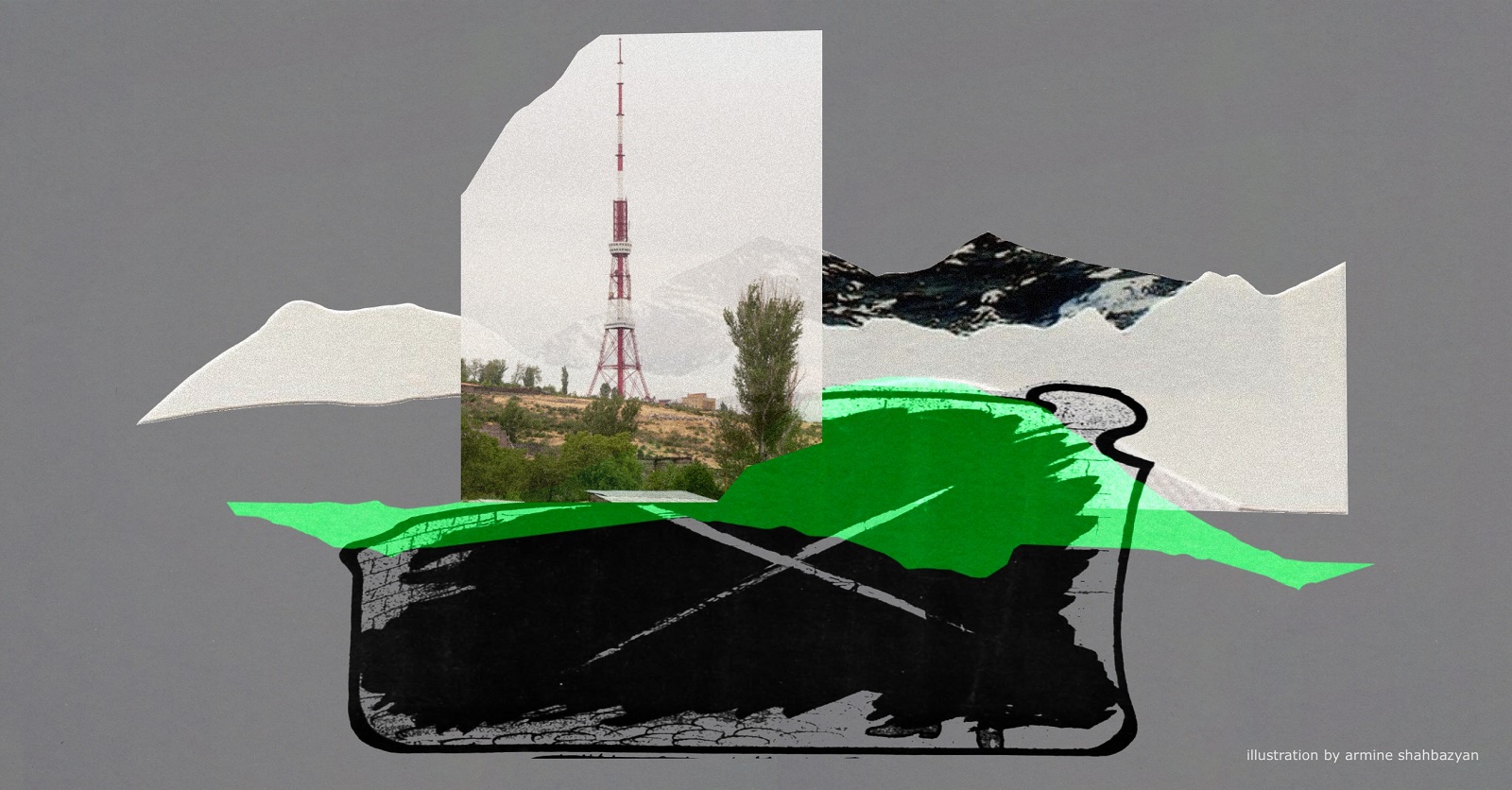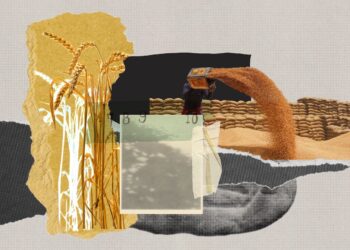
Listen to the article.
Hazardous chemical substances in Armenia have been improperly managed and unsafely stored for decades.
Approximately 50 small and five large chemical waste landfills/burial grounds exist across the country. Small areas storing hazardous chemicals are, for example, school and university laboratories. The larger ones, which fail to meet safety standards, are former factory storage areas like the Nairit Chemical Plant, the Vanadzor Kimprom factory, the Alaverdi Arsenic “graveyard”, and the Haygyughkimia production facility storage. These sites were once operational factories, but they were abandoned, leaving behind large amounts of hazardous chemicals. The only storage purpose-built chemical storage site is the Nubarashen toxic waste site.
“To some extent, the Nubarashen storage meets some safety standards that other locations absolutely don’t. The chemicals remain as they were the day the factory closed. In many cases, the walls are eroding, and the chemicals are seeping into the terrain,” says environmental engineer Ani Bayburdyan.
In Bayburdyan’s 2022 research, she traced expired chemicals stored across Armenia. She revealed a total of 71,900 kg of hazardous chemical waste in storage — Ararat Region: 28,040 kg, Lori: 21,600 kg, Armavir: 7,000 kg, Tavush: 6,000 kg, Gegharkunik: 3.730 kg, Shirak: 2,500 kg, Syunik: 2,330 kg, and Vayots Dzor: 700 kg.
“Contamination not only poses grave risks to soil, vegetation, animals, and humans, but such quantities of chemicals could also be used as a chemical weapon in the wrong hands,” says Bayburdyan.
A City Atop a “Chemical Weapon”
The Nubarashen toxic waste site was built in the late 1970s in a suburb of Yerevan. This was when several chemicals, such as dichlorodiphenyltrichloroethane (DDT, an environmentally and humanly harmful insecticide) and later hexachlorocyclohexane, both persistent organic pollutants, were universally banned, including in the USSR. The Ministry of Environment explains that a USSR-wide directive was issued at the time, instructing the removal of banned and expired chemicals from the supply chain in all Republics and required their containment in landfills.
Nubarashen was chosen for its distance from Yerevan’s general population. Over time, however, not only did the city expand to subsume Nubarashen, in the 1990s, it was also discovered that the area is subject to severe erosion processes which remain active today, putting several nearby villages at risk of evacuation.
Further landslides could put the Nubarashen landfill at risk of spillover, contaminating the area.
The Ministry of Environment has updated the list of possible types of chemicals buried in the Nubarashen toxic waste landfill. It includes 500 tons of 34 types of hazardous chemicals of different classifications. This list includes 192.5 tons of DDT, 48.396 tons of hexachlorocyclohexane, 42.640 tons of calcium arsenate, and 33.121 tons of endobacteria among others.
“This is a very serious issue, akin to living on top of a chemical weapon,” says Ani Bayburdyan, adding that most of the area’s population is unaware of the chemical waste storage facility. “The community needs to be informed, warned, and educated about this, especially considering people are engaged in animal husbandry in the vicinity,” she explains.
The facility’s only precautionary measure is a barbed wire fence, which serves more as a marker for the waste dump’s location rather than a deterrent to prevent trespassing. This is despite the facility being included in the list of state buildings and facilities under police protection.
Bayburdyan’s studies have uncovered engineering and construction errors in the building of the chemical waste depot. It was found that no geological study of the area was conducted beforehand, there are no maps of the chemicals in the dump, and the walls of the five cells at the depot are not made of concrete, leading to cross-contamination.
“From the outside, the Nubarashen toxic waste site appears as a large hill, under which are the cells where hazardous waste is stored. Ideally, it should resemble a depot. Two out of the five wells are already damp and on the verge of collapse, while the other three are in relatively better condition,” says Bayburdyan.
Armenia reaffirmed its commitment to responsible hazardous waste management by ratifying the Stockholm Convention on Persistent Organic Pollutants. The convention was signed by 128 countries between 2001-2004. It mandates the disposal of hazardous material, such as that in the Nubarashen landfill, by 2025.
The Convention also outlines technical and financial support for signatories. Consequently, the UN and the OSCE have partnered with Armenia.
A 2013 OSCE study reports that since 2010, measures have been implemented and repair work conducted at the landfill to temporarily ensure hermeticity until a final solution is found.
“The risk to the environment and human health persists even after repairs,” according to the study. This is due to the 0.6 hectares of barren soil around the landfill being contaminated to a depth of 0.5 meters. The study further warns that “if nothing is done accelerated site erosion will continue and off site migration of contaminants will increase, enlarging the environmental and human risks.”
Irresponsible = Irreparable?
Bayburdyan states that nothing is currently being done. She suggests that the fastest way to dispose of the waste would be by burning in specialized ovens, which Armenia lacks. The idea of shipping the waste to France for disposal was also considered, but Georgia denied permission for the hazardous waste to be transported through its territory. “Iran is the only neighbor who possesses these specialized ovens. So, we have three options — we either acquire these ovens ourselves, convince Georgia to allow permission for the waste transport, or we transport the waste to Iran, which could introduce political challenges,” Bayburdyan notes.
EVN Report reached out to the Ministry of Interior Affairs, the Ministry of Environment, and the Ministry of Health to identify the institution responsible for the situation.
Eventually, the Ministry of Interior pinpointed the Ministry of Environment as the responsible party. They also noted that “the landfill is in a landslide zone and located downhill from small landslides, which if activated can overrun the landfill.”
The Ministry of Environment responded by stating that the Convention sets specific deadlines for managing and disposing of hazardous substances. Currently the Ministry is evaluating potential options for the environmentally safe disposal of persistent organic pollutants. They are also developing draft legal frameworks that define the guidelines for using waste containing polychlorinated biphenyls and expired pesticides. According to the Ministry, these frameworks are expected to be implemented in 2024.
In terms of liability for non-compliance with the Convention’s requirements, the Ministry cited Article 17, which states: “The Conference of the Parties shall, as soon as practicable, develop and approve procedures and institutional mechanisms for determining non-compliance with the provisions of this Convention and for the treatment of Parties found to be in non-compliance.”
The Ministry of Health, without denying or confirming any direct involvement with the chemical depot, responded by stating the obvious: “Environmental pollution, including chemical compounds, depending on their composition, the amount, ways of absorption and the duration of exposure can increase the risk of various non-infectious diseases among the impacted population. In particular, it can cause acute poisoning and have long-term effects.”
The Yerevan Municipality has not included the matter on its agenda. While the 2019-2023 five-year action plan identified the Nubarashen toxic waste site as a potential health hazard to the capital’s population; the 2024-2028 plan does not mention it.
Bayburdyan asserts that Armenia could store its hazardous chemicals properly with financial investment. “It is not a matter of billions of dollars,” she stresses. “We are a signatory of a convention, which allows for financial assistance from other member countries. This is not a problem without a solution, but it is an issue, which concerns the health and the safety of the population. Thus, we are obliged to find financial solutions.”
Bayburdyan further points out that Nubarashen, being in the capital, is not as neglected as other areas that are in even worse conditions: “Some have even been privatized with minimal oversight and no access. At least the state can access the Nubarashen dump. These specific safety concerns warrant concentrated attention.”
It is time to address the danger buried under the city for over 40 years and fulfill the “promise” made 20 years ago. The time is up.
Law and Society
Enforcement Deficit: Car Seat Laws in Armenia
Although the use of car seats is mandatory in Armenia, it is not being implemented and road police are not addressing the issue. Margarita Ghazaryan addresses the Armenian experience of ensuring the safety of children.
Read moreElectronic Justice: Risks and Opportunities
As of February 1, all procedural documentation in new civil cases will be required to be submitted electronically. Astghik Karapetyan discusses the goals, challenges and opportunities presented by the electronic judicial system.
Read moreThe Bread Dilemma: Choosing Between Wheat Imports and Domestic Cultivation
Wheat production and import are critical security issues for Armenia. Lilit Avagyan delves into the measures taken to ensure Armenia's food security, focusing on increasing wheat self-sufficiency and maintaining ongoing wheat imports.
Read moreResolving the Unresolved Issue of Garbage
Despite several legislative regulations, adopted strategies and promises, waste management continues to be unresolved in Armenia. Hasmik Baleyan explains.
Read more





